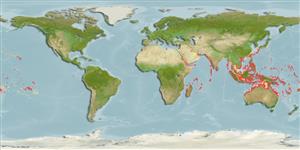Hexacorallia |
Scleractinia |
Lobophylliidae
Environment: milieu / climate zone / depth range / distribution range
Ecology
Reef-associated; depth range 0 - 40 m (Ref. 848). Tropical; 36°N - 34°S, 32°E - 135°W (Ref. 848)
Indo-Pacific: widespread in East Africa, including Red Sea to Polynesia, north to Japan and south to Solitary Islands, Australia.
Length at first maturity / Size / Weight / Age
Maturity: Lm ? range ? - ? cm
Formation: encrusting to massive, rarely over 1 m across. Corallites: cerioid or subplocoid, circular, with thick walls. Septa have long pointed teeth. Thick fleshy tissue over the skeleton present, usually forming concentric folds. Color: uniform or mottled dull brown, gray or green, but can also be brightly colored (Ref. 848).
Occurs in most reef environments (Ref. 848).
Life cycle and mating behavior
Maturity | Reproduction | Spawning | Eggs | Fecundity | Larvae
Hermaphroditic (Refs. 113708, 113712). Mature gametes are shed into the coelenteron and spawned through the mouth. Life cycle: The zygote develops into a planktonic planula larva. Metamorphosis begins with early morphogenesis of tentacles, septa and pharynx before larval settlement on the aboral end (Ref. 833).
Veron, J.E.N. and G. Hodgson 1989 Annotated checklist of the hermatypic corals of the Philippines. Pacific Science 43:234-287. (Ref. 8817)
IUCN Red List Status
(Ref. 130435: Version 2025-1)
CITES status (Ref. 108899)
Not Evaluated
Threat to humans
Human uses
| FishSource |
Tools
More information
Trophic EcologyFood items (preys)
Diet composition
Food consumption
Predators
Population dynamicsGrowth
Max. ages / sizes
Length-weight rel.
Length-length rel.
Length-frequencies
Mass conversion
Abundance
PhysiologyOxygen consumption
Human RelatedStamps, coins, misc.
Internet sources
Estimates based on models
Preferred temperature
(Ref.
115969): 24.6 - 29, mean 27.9 (based on 1012 cells).
Price category
Unknown.
